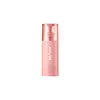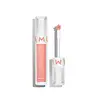AMUSE Cheek Tok Tok Versus AMUSE Soft Cream Cheek
What's inside
What's inside
 Key Ingredients
Key Ingredients

 Benefits
Benefits

 Concerns
Concerns

 Ingredients Side-by-side
Ingredients Side-by-side

Dimethicone
EmollientMica
Cosmetic ColorantPhenyl Trimethicone
Skin ConditioningIsononyl Isononanoate
EmollientIsododecane
EmollientPolyisobutene
Vinyl Dimethicone/Methicone Silsesquioxane Crosspolymer
Dimethicone Crosspolymer
Emulsion StabilisingDiisostearyl Malate
EmollientTrimethylsiloxysilicate
EmollientCI 77891
Cosmetic ColorantLauryl Polyglyceryl-3 Polydimethylsiloxyethyl Dimethicone
Skin ConditioningHdi/Trimethylol Hexyllactone Crosspolymer
Disteardimonium Hectorite
Stabilising1,2-Hexanediol
Skin ConditioningCI 15985
Cosmetic ColorantParfum
MaskingPropylene Carbonate
SolventCI 77491
Cosmetic ColorantCaprylyl Glycol
EmollientPentaerythrityl Tetra-Di-T-Butyl Hydroxyhydrocinnamate
AntioxidantEthylhexylglycerin
Skin ConditioningLaureth-4
EmulsifyingCI 15850
Cosmetic ColorantSilica
AbrasiveCI 77499
Cosmetic ColorantTocopherol
AntioxidantWater
Skin ConditioningButylene Glycol
HumectantGlycine Soja Protein
EmulsifyingHydrolyzed Lupine Protein
Skin ConditioningHydrolyzed Sweet Almond Protein
Skin ConditioningHydrolyzed Corn Protein
Skin ConditioningHydrolyzed Soy Protein
HumectantHydrolyzed Rice Protein
Skin ConditioningHydrolyzed Vegetable Protein
Skin ConditioningAcetyl Hexapeptide-8
HumectantCopper Tripeptide-1
Skin ConditioningDipeptide Diaminobutyroyl Benzylamide Diacetate
Skin ConditioningHexapeptide-9
Skin ConditioningNonapeptide-1
Skin ConditioningPalmitoyl Pentapeptide-4
Skin ConditioningPalmitoyl Tetrapeptide-7
Skin ConditioningPalmitoyl Tripeptide-5
Skin ConditioningPalmitoyl Hexapeptide-12
Skin ConditioningPalmitoyl Tripeptide-1
Skin ConditioningPentapeptide-3
Skin ConditioningTripeptide-1
Skin ConditioningDimethicone, Mica, Phenyl Trimethicone, Isononyl Isononanoate, Isododecane, Polyisobutene, Vinyl Dimethicone/Methicone Silsesquioxane Crosspolymer, Dimethicone Crosspolymer, Diisostearyl Malate, Trimethylsiloxysilicate, CI 77891, Lauryl Polyglyceryl-3 Polydimethylsiloxyethyl Dimethicone, Hdi/Trimethylol Hexyllactone Crosspolymer, Disteardimonium Hectorite, 1,2-Hexanediol, CI 15985, Parfum, Propylene Carbonate, CI 77491, Caprylyl Glycol, Pentaerythrityl Tetra-Di-T-Butyl Hydroxyhydrocinnamate, Ethylhexylglycerin, Laureth-4, CI 15850, Silica, CI 77499, Tocopherol, Water, Butylene Glycol, Glycine Soja Protein, Hydrolyzed Lupine Protein, Hydrolyzed Sweet Almond Protein, Hydrolyzed Corn Protein, Hydrolyzed Soy Protein, Hydrolyzed Rice Protein, Hydrolyzed Vegetable Protein, Acetyl Hexapeptide-8, Copper Tripeptide-1, Dipeptide Diaminobutyroyl Benzylamide Diacetate, Hexapeptide-9, Nonapeptide-1, Palmitoyl Pentapeptide-4, Palmitoyl Tetrapeptide-7, Palmitoyl Tripeptide-5, Palmitoyl Hexapeptide-12, Palmitoyl Tripeptide-1, Pentapeptide-3, Tripeptide-1
Water
Skin ConditioningCyclopentasiloxane
EmollientMethyl Trimethicone
Skin ConditioningMica
Cosmetic ColorantGlycerin
HumectantPEG-10 Dimethicone
Skin ConditioningDicaprylyl Carbonate
EmollientDisteardimonium Hectorite
StabilisingNeopentyl Glycol Diheptanoate
EmollientPentylene Glycol
Skin ConditioningMethyl Methacrylate Crosspolymer-2
Sorbitan Isostearate
EmulsifyingVinyl Dimethicone/Methicone Silsesquioxane Crosspolymer
Magnesium Sulfate
Dimethicone/Vinyl Dimethicone Crosspolymer
Skin ConditioningCetearyl Dimethicone/Vinyl Dimethicone Crosspolymer
EmollientGlyceryl Caprylate
EmollientTriethoxycaprylylsilane
Trisodium Ethylenediamine Disuccinate
Aluminum Hydroxide
EmollientAscorbic Acid Polypeptide
AntioxidantBeta-Glucan
Skin ConditioningTocopherol
AntioxidantParfum
MaskingCI 77891
Cosmetic ColorantCI 77491
Cosmetic ColorantCI 73360
Cosmetic ColorantCI 77492
Cosmetic ColorantCI 77499
Cosmetic ColorantCI 77007
Cosmetic ColorantWater, Cyclopentasiloxane, Methyl Trimethicone, Mica, Glycerin, PEG-10 Dimethicone, Dicaprylyl Carbonate, Disteardimonium Hectorite, Neopentyl Glycol Diheptanoate, Pentylene Glycol, Methyl Methacrylate Crosspolymer-2, Sorbitan Isostearate, Vinyl Dimethicone/Methicone Silsesquioxane Crosspolymer, Magnesium Sulfate, Dimethicone/Vinyl Dimethicone Crosspolymer, Cetearyl Dimethicone/Vinyl Dimethicone Crosspolymer, Glyceryl Caprylate, Triethoxycaprylylsilane, Trisodium Ethylenediamine Disuccinate, Aluminum Hydroxide, Ascorbic Acid Polypeptide, Beta-Glucan, Tocopherol, Parfum, CI 77891, CI 77491, CI 73360, CI 77492, CI 77499, CI 77007
Ingredients Explained
These ingredients are found in both products.
Ingredients higher up in an ingredient list are typically present in a larger amount.
Ci 77491 is also hydrated iron III oxide. It's sole purpose is to give a red/pink hue to products.
Iron III oxides are classified as inorganic chemicals for coloring.
Synthetically created Ci 77491 is considered safer than those naturally found. This is because the synthetically created version may contain less impurities. Iron oxides are generally non-toxic and non-allergenic.
Learn more about CI 77491Ci 77499 is also hydrated iron III oxide. It is created from mixing red and black iron oxides. This helps give shades of darkness to a product.
Iron III oxides are classified as inorganic chemicals for coloring.
Ci 77891 is a white pigment from Titanium dioxide. It is naturally found in minerals such as rutile and ilmenite.
It's main function is to add a white color to cosmetics. It can also be mixed with other colors to create different shades.
Ci 77891 is commonly found in sunscreens due to its ability to block UV rays.
Learn more about CI 77891Disteardimonium Hectorite comes from the clay mineral named hectorite. It is used to add thickness to a product.
It can also help stabilize a product by helping to disperse other ingredients.
Hectorite is a rare, white clay mineral.
Learn more about Disteardimonium HectoriteMica is a naturally occurring mineral used to add shimmer and color in cosmetics. It can also help improve the texture of a product or give it an opaque, white/silver color.
Serecite is the name for very fine but ragged grains of mica.
This ingredient is often coated with metal oxides like titanium dioxide. Trace amounts of heavy metals may be found in mica, but these metals are not harmful in our personal products.
Mica has been used since prehistoric times throughout the world. Ancient Egyptian, Indian, Greek, Roman, Aztec, and Chinese civilizations have used mica.
Learn more about MicaParfum is a catch-all term for an ingredient or more that is used to give a scent to products.
Also called "fragrance", this ingredient can be a blend of hundreds of chemicals or plant oils. This means every product with "fragrance" or "parfum" in the ingredients list is a different mixture.
For instance, Habanolide is a proprietary trade name for a specific aroma chemical. When used as a fragrance ingredient in cosmetics, most aroma chemicals fall under the broad labeling category of “FRAGRANCE” or “PARFUM” according to EU and US regulations.
The term 'parfum' or 'fragrance' is not regulated in many countries. In many cases, it is up to the brand to define this term.
For instance, many brands choose to label themselves as "fragrance-free" because they are not using synthetic fragrances. However, their products may still contain ingredients such as essential oils that are considered a fragrance by INCI standards.
One example is Calendula flower extract. Calendula is an essential oil that still imparts a scent or 'fragrance'.
Depending on the blend, the ingredients in the mixture can cause allergies and sensitivities on the skin. Some ingredients that are known EU allergens include linalool and citronellol.
Parfum can also be used to mask or cover an unpleasant scent.
The bottom line is: not all fragrances/parfum/ingredients are created equally. If you are worried about fragrances, we recommend taking a closer look at an ingredient. And of course, we always recommend speaking with a professional.
Learn more about ParfumTocopherol (also known as Vitamin E) is a common antioxidant used to help protect the skin from free-radicals and strengthen the skin barrier. It's also fat soluble - this means our skin is great at absorbing it.
Vitamin E also helps keep your natural skin lipids healthy. Your lipid skin barrier naturally consists of lipids, ceramides, and fatty acids. Vitamin E offers extra protection for your skin’s lipid barrier, keeping your skin healthy and nourished.
Another benefit is a bit of UV protection. Vitamin E helps reduce the damage caused by UVB rays. (It should not replace your sunscreen). Combining it with Vitamin C can decrease sunburned cells and hyperpigmentation after UV exposure.
You might have noticed Vitamin E + C often paired together. This is because it is great at stabilizing Vitamin C. Using the two together helps increase the effectiveness of both ingredients.
There are often claims that Vitamin E can reduce/prevent scarring, but these claims haven't been confirmed by scientific research.
Learn more about TocopherolThis ingredient is used in makeup and skincare to thicken formulas, reduce shine, and give skin a silky-smooth feel.
It’s a white silicone powder that sits in fine lines and pores to blur their appearance though its effectiveness depends on the particle size.
You'll typically find this ingredient in amounts between 0.1-20%.
Learn more about Vinyl Dimethicone/Methicone Silsesquioxane CrosspolymerWater. It's the most common cosmetic ingredient of all. You'll usually see it at the top of ingredient lists, meaning that it makes up the largest part of the product.
So why is it so popular? Water most often acts as a solvent - this means that it helps dissolve other ingredients into the formulation.
You'll also recognize water as that liquid we all need to stay alive. If you see this, drink a glass of water. Stay hydrated!
Learn more about Water